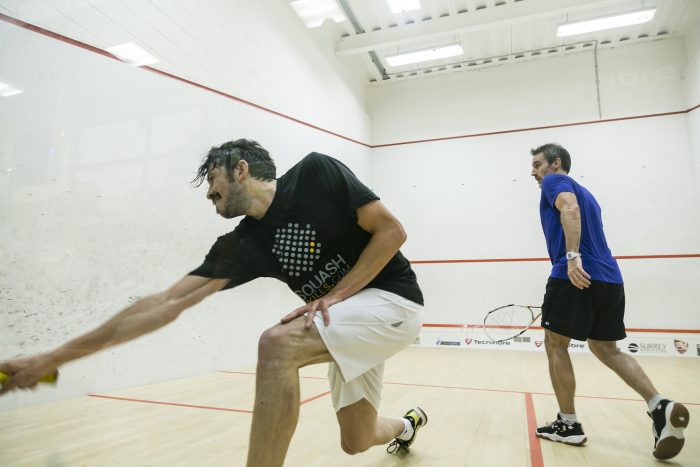Due to the intensity of the sport of squash and the enclosed environment within which the game takes place, players will inevitably sweat heavily over the course of a match.
Water is an incredibly important element for the function of the body – while the production of sweat helps to regulate body temperature, losing too much fluid during a game/training session can seriously affect performance and subsequent recovery. Mild dehydration in the range of even just a 2% loss of body mass, has been demonstrated to have the potential to cause significant drops in mental and physical performance.
Those that sweat particularly heavily on the court may be surprised at just how much fluid they secrete during a match; a detailed study during the squash World Teams Championships several years ago, showed that players were sweating out anywhere up to 4kg of weight during a match – each kilogram of sweat that you lose is the equivalent of around 1 litre of fluid, so that’s 4 litres of fluid streaming out of those players over the course of a gruelling match.
Those figures are on the higher end – rates of sweat loss are highly individualistic – but typical fluid deficits for most players are still likely to be around at least 1.5 litres per hour of game/training.
 Obviously your sweat loss will depend somewhat on heat/humidity conditions and other variables such as the intensity of the session, but by getting a rough idea of your normal amount of water weight loss you can gain a good general idea of how much you personally need to be drinking before and during your games/training, to help optimise performance and avoid any degradation of mind or body. Relying just on your thirst to guide fluid intake is not a dependable method, as research shows that athletes will rarely voluntarily drink sufficient fluid to replace the sweat being lost during exercise.
Obviously your sweat loss will depend somewhat on heat/humidity conditions and other variables such as the intensity of the session, but by getting a rough idea of your normal amount of water weight loss you can gain a good general idea of how much you personally need to be drinking before and during your games/training, to help optimise performance and avoid any degradation of mind or body. Relying just on your thirst to guide fluid intake is not a dependable method, as research shows that athletes will rarely voluntarily drink sufficient fluid to replace the sweat being lost during exercise.
An easy way to measure your own personal level of sweat loss while playing and to help you account for how much fluid you need to be taking on is to weigh yourself before and after you play.
Weigh yourself wearing minimal clothing in the changing rooms before you start, and then again immediately afterwards (drying off any excess sweat first). Factor in how much water you drank during the game and offset that from the total number of kilos that you’ve dropped, to give yourself a total of how much fluid weight you’ve lost – repeat this process several times across a couple of weeks, to give yourself a general range of your typical sweat losses during an on-court session.
 Due to the fact beverages can only be taken on in the limited break between games, it can often be difficult to ensure you actually have the time needed to drink enough to replace those fluids you’re losing.
Due to the fact beverages can only be taken on in the limited break between games, it can often be difficult to ensure you actually have the time needed to drink enough to replace those fluids you’re losing.
Making sure you’re fully hydrated before you begin play is thus crucially important, alongside preparing your drinks for your session in advance and not relying on just a quick slurp from the drinking fountain mid-match. Post-session hydration is an important consideration as well, particularly if you’re going to be training or playing again later the same day (properly formulated recovery drinks can be very useful here).
What you actually drink is important to consider also.
In most cases, plain water is fine – cool water is often recommended to be easier and more palatable to consume as compared to ice-cold water. For longer duration, 1hr+ games/sessions, however (or for those who are particularly heavy sweaters), replacement of lost minerals is also an important consideration.
Although sweat is mostly water, dissolved in the water are trace amounts of minerals, lactic acid, and urea. Exact mineral volumes vary, but will include concentrations of electrolytes such as sodium, potassium, calcium, and magnesium, as well as tiny amounts of zinc, copper, iron, chromium, nickel, and lead.
The most important of these in terms of replacement during exercise is sodium (salt). Small quantities of sodium can enhance palatability of beverages and stimulate thirst, and help maintain physical performance.
Drinking fluids containing small amounts of sodium can also help prevent hyponatremia in susceptible individuals (hyponatremia is a condition whereby sodium concentration is lower than normal, which can lead to vomiting, headache, dizziness, cramps, seizures, and even potential loss of consciousness and death in very extreme cases). Although very rare, excessive water intake without sodium replacement may result in the dilution of plasma sodium levels, and increase the risk of this exercise-associated hyponatremia.
Taking in some sugary carbs may also be beneficial if your game/sessions lasts an hour or more, to help fuel and power your muscles beyond the limitations of your normal energy reserves.
Gary Nisbet
B.Sc.(Hons), CSCS, NSCA-CPT, Dip. FTST
SquashSkills Fitness & Performance Director
Sign up to the SquashSkills newsletter
Get world class coaching tips, straight to your inbox!